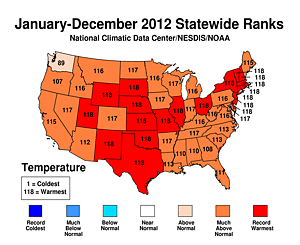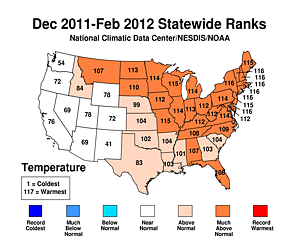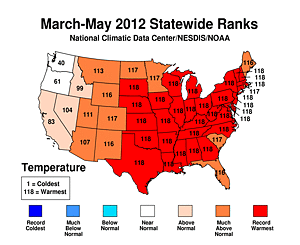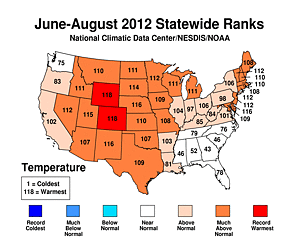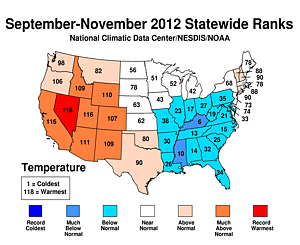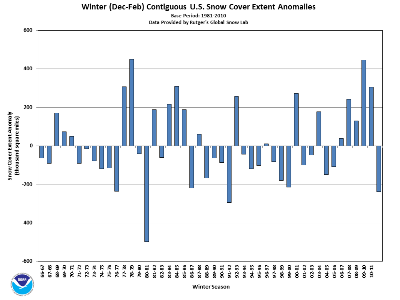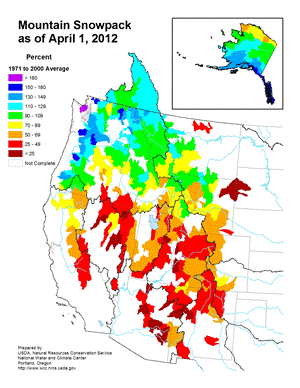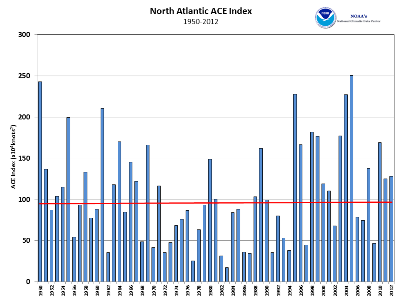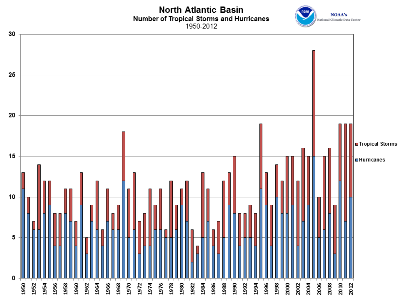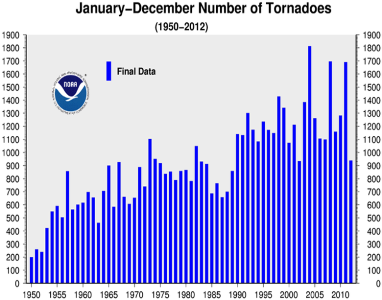Climate Extremes Index | Tornadoes | Tropical Cyclones | Snow
Map of U.S. Climate Regions | Map of U.S. Climate Divisions
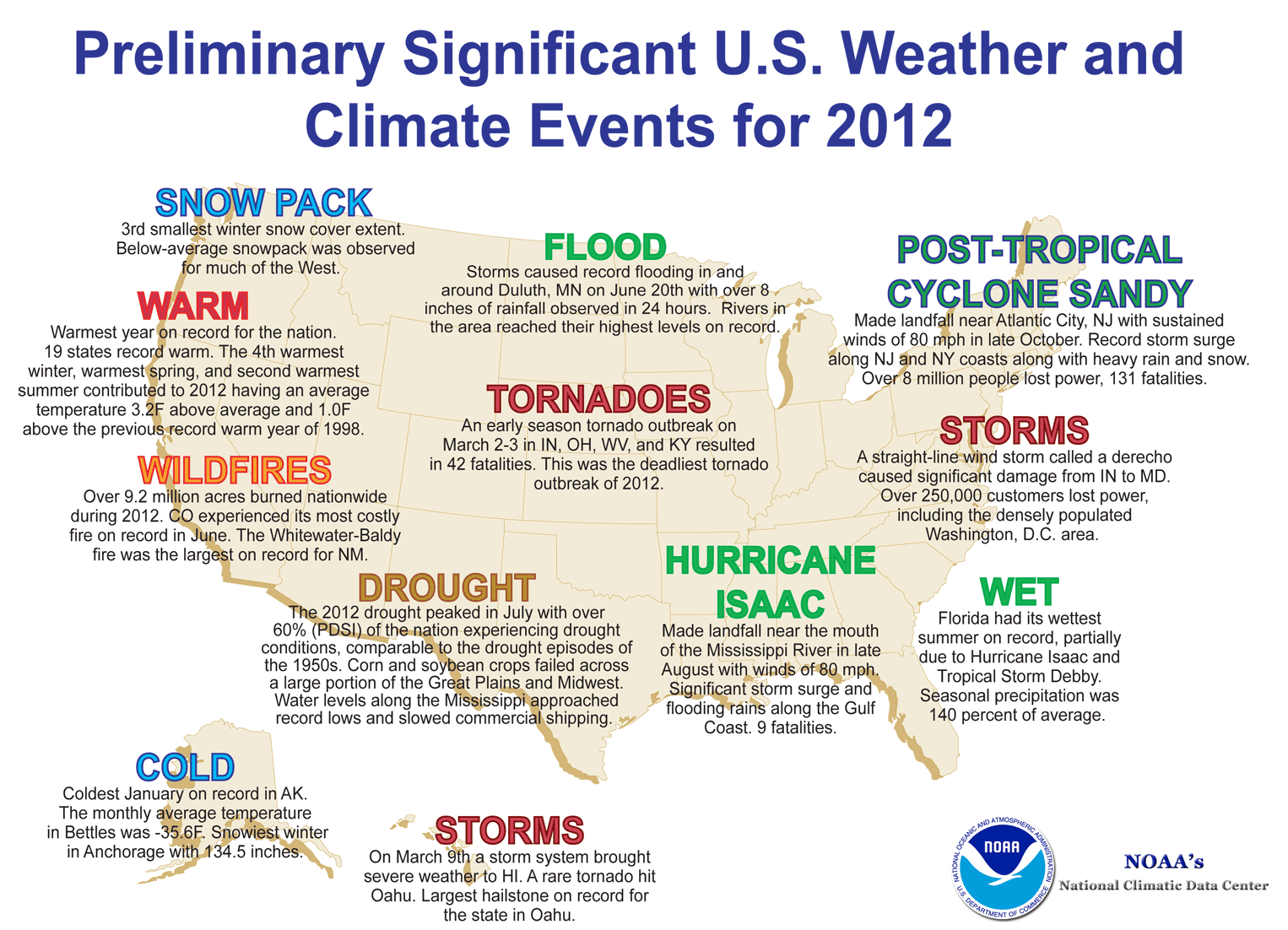
2012 National Events Map
Click for more information
Issued January 8, 2013: The data presented in this report are final through July and preliminary from August-December. Ranks, anomalies, and percent areas may change as more complete data are received and processed.
National Temperature and Precipitation Analysis
In 2012, the contiguous United States (CONUS) average annual temperature of 55.3°F was 3.2°F above the 20th century average, and was the warmest year in the 1895-2012 period of record for the nation. The 2012 annual temperature was 1.0°F warmer than the previous record warm year of 1998. Since 1895, the CONUS has observed a long-term temperature increase of about 0.13°F per decade. Precipitation averaged across the CONUS in 2012 was 26.57 inches, which is 2.57 inches below the 20th century average. Precipitation totals in 2012 ranked as the 15th driest year on record. Over the 118-year period of record, precipitation across the CONUS has increased at a rate of about 0.16 inch per decade.
On a statewide and seasonal level, 2012 was a year of both temperature and precipitation extremes for the United States. Each state in the CONUS had annual temperatures which were above average. Nineteen states, stretching from Utah to Massachusetts, had annual temperatures which were record warm. An additional 26 states had one of their 10 warmest years. Only Georgia (11th warmest year), Oregon (12th warmest), and Washington (30th warmest) had annual temperatures that were not among the ten warmest in their respective period of records. A list of the annual temperatures for each of the lower-48 states is available here. Numerous cities and towns were also record warm during 2012 and a select list of those locations is available here. Each state in the CONUS, except Washington, had at least one location experience its warmest year on record. One notable warmest year record occurred in Central Park, in New York City, which has a period of record dating back 136 years.
Much of the CONUS was drier than average for the year. Below-average precipitation totals stretched from the Intermountain West, through the Great Plains, into the Midwest and Southeast. Nebraska and Wyoming were both record dry in 2012. Nebraska’s annual precipitation total of 13.04 inches was 9.78 inches below average, and Wyoming’s annual precipitation total of 8.08 inches was 5.09 inches below average. New Mexico, Colorado, Kansas, Missouri, Illinois, Arkansas, Georgia, and Delaware had a top ten dry year. The large area of dry conditions in 2012 resulted in a very large footprint of drought conditions, which peaked in July with about 61 percent of the CONUS in moderate-to-exceptional drought, according to the Palmer Drought Severity Index (PDSI). The footprint of drought during 2012 roughly equaled the drought of the 1950s which peaked at approximately 60 percent. Wetter-than-average conditions were present for the Northwest, where Washington had its fifth wettest year on record. Washington’s statewide precipitation total of 47.24 inches was 10.40 inches above average. Wetter-than-average conditions were also present across parts of the Gulf Coast and Northeast.
Seasonal highlights in 2012 include the fourth warmest winter (December 2011-February 2012), with warmer-than-average conditions across a large portion of the country. The largest temperature departures from average were across the Northern Plains, Midwest, Mid-Atlantic, and Northeast. Winter was drier than average for the East and West coasts, while the Southern Plains were wetter than average improving drought conditions across New Mexico, Oklahoma, and Texas. The warmer and drier than average conditions resulted in the third smallest winter snow cover extent on record for the contiguous United States. Spring (March-May) was record warm for the country, with 34 states being record warm for the period. The season consisted of the warmest March, fourth warmest April, and second warmest May on record. Spring precipitation was near-average for the lower-48, with the Pacific Northwest and Upper Midwest being wetter than average, while the Central Rockies and Ohio Valley were drier than average. The summer (June-August) continued the warmer-than-average trend for the contiguous U.S. with national temperatures ranking as the second warmest on record. The summer average temperature for 2012 was very close to the warmest summer (2011) and the third warmest summer (1936), with only 0.1°F separating the three. The summer season consisted of the eighth warmest June, record warmest July, and 13th warmest August. Drier-than-average conditions were anchored in the central U.S. with record breaking wildfires and a drought footprint comparable to the drought episodes of the 1950s causing large-scale agriculture problems in the Midwest, Plains, and Mountain West. Autumn (September-November) temperatures were closer to average compared to the preceding three seasons, but still ranked as the 22nd warmest autumn on record. Warmer-than-average conditions were present for the West, while cooler-than-average conditions were present for the Eastern Seaboard. Precipitation totals for the nation averaged as the 22nd driest autumn on record.
This annual report places the temperature and precipitation averages into historical perspective, while summarizing the notable events that occurred in 2012. More detailed analysis on individual months can be found through the Climate Monitoring home page.
Top Ten U.S. Weather/Climate Events for 2012
| Rank | Event |
|---|---|
| 1 | Hurricane/Post-Tropical Storm Sandy |
| 2 | Contiguous U.S. Drought |
| 3 | Contiguous U.S. Warmest Year on Record |
| 4 | Record Wildfire Activity |
| 5 | Multi-State Derecho |
| 6 | March 2nd-3rd Severe Weather Outbreak |
| 7 | Alaska Cold Winter/Snow Records |
| 8 | Near-Record Low Great Lakes Levels |
| 9 | Contiguous U.S. Snow Cover |
| 10 | Hurricane Isaac |
Seasonal Analysis
Winter
The 2011/12 winter season was marked by above-average temperatures for a large portion of the nation, stretching from the Rockies, through the Plains, and along the East Coast. The Northern Plains, Midwest, and Northeast had the largest temperature departures from average for the season. The CONUS had an average winter temperature of 36.4°F, which was 3.8°F above the 20th century average and was the fourth warmest winter on record. In total, 22 states had December-February temperatures ranking among their ten warmest and four states in the West had winter temperatures which were near-normal. This winter season contrasted with the previous two winters for the CONUS (2009/10 and 2010/11) which ranked as the 14th and 34th coldest winter seasons, respectively. The 2009/10 and 2010/11 winters were marked by record and near-record negative phases of the North Atlantic (NAO) and Arctic (AO) oscillations, which were associated with frequent and long-lasting cold-air outbreaks. The 2011/12 winter had the opposite configuration of the NAO and AO. The NAO averaged for December 2011 was +2.52, the largest positive phase of the index for a month on record. When the NAO and AO are in a positive phase during the winter, the jet stream, which divides cold Arctic air to the north and warm sub-tropical air to the south, tends to remain north of the U.S.-Canadian border. This was the case for the 2011/12 winter which was marked by few and short-lived cold air outbreaks in the CONUS.
The presence of La Niña during the winter had a minimal influence on precipitation patterns during the season. The 3-month average CONUS precipitation of 5.77 inches was 0.70 inch below average. The western U.S. was drier than average, where California had its third driest winter on record, with a statewide precipitation total of 4.09 inches, 7.82 inches below average. Drier-than-average conditions stretched across the Northern Plains into the Upper Midwest. Much of the Eastern Seaboard was also drier than average, where North Carolina had its ninth driest winter and South Carolina its sixth driest. The warm and dry conditions during winter limited snow across a large portion of the country, and the CONUS had its third smallest seasonal snow cover since satellite records began 46 years ago. Many of the major cities in the Northeast and Midwest had record and near-record low seasonal snowfall. Wetter-than-average conditions occurred in the Southern Plains, where Texas had its tenth wettest winter with a precipitation total of 7.63 inches, 2.50 inches above average. The above-average winter precipitation in Texas helped to improve drought conditions which plagued the state during much of 2011. Above-average precipitation was also present for parts of Ohio Valley. The drier-than-average conditions observed along the East Coast and wetter-than-average conditions in the Ohio Valley are consistent with La Niña, but the winter wetness in the Southern Plains is more typical of an El Niño, not a La Niña.
Spring
The spring (March-May) of 2012 was marked by record warmth over a large portion of the country. The CONUS average temperature for the season was 56.1°F, 5.2°F above the 20th century average, and the warmest spring on record, by 2.0°F. The previous record warm spring occurred in 1910 with a seasonally averaged temperature of 54.1°F. Spring 2012 also marked the largest warm temperature departure from average for any season on record for the CONUS. All three months of the season ranked among their five warmest, also a first for the nation. The March average temperature was 8.6°F above average and the record warmest March, April was 3.6°F above average and the fourth warmest April, and May was 3.5°F above average, the second warmest May on record. Thirty-four states0 were record warm for spring, all east of the Rockies, while an additional eight states were top ten warm. The U.S. Climate Extremes Index (USCEI) was record large for the season, driven mostly by the large footprint in extremely warm daytime and warm nighttime temperatures. Numerous states, mostly across the Midwest, had spring temperatures more than 7.0°F above average. Only Oregon and Washington had seasonal temperatures near normal.
The spring CONUS precipitation total of 7.32 inches was 0.39 inch below average and ranked near the median value. The near-average CONUS precipitation total masked regional extremes on both the wet and dry ends of the spectrum. The Pacific Northwest was bombarded by numerous storms during the spring season, resulting in Oregon and Washington having seasonal precipitation totals among their ten wettest. The active storm pattern resulted in above-average snowpack for the Cascades of Oregon and Washington, with near-normal snowpack stretching eastward through the northern Rockies of Idaho, Montana, and northern Wyoming. The Upper Midwest was also wetter than average, where Minnesota had its third wettest spring. Below-average precipitation totals were centered in the central Rockies and the Ohio Valley. Colorado, Utah, and Wyoming each had a top ten dry spring season, where below-average snowpack resulted. In the Ohio Valley, Indiana and Tennessee both had a top ten dry spring. The below-average precipitation in the Midwest was accompanied by below-average tornado activity, despite a few deadly tornado outbreaks. The warm and dry spring, in combination with other factors, played precursor to the large expansion of drought which impacted the nation during the summer of 2012.
Summer
The summer (June-August) of 2012 brought a continuation of warmer-than-average conditions for a large area of the CONUS. The summer’s average temperature for the CONUS was 73.8°F, 2.6°F above the 20th century average and the second warmest summer on record. Only the summer of 2011 was warmer. Above-average temperatures were present for the Rockies, Great Plains, Midwest, Northeast, and much of the West, with the exception of Washington State. The Southeast had near-normal summer temperatures. Colorado and Wyoming each had their warmest summer on record, with 3-month average temperatures 4.9°F and 4.6°F above average, respectively. Twenty-one additional states had summer temperatures among their ten warmest. During the summer, at least 357 all-time hot daytime temperature records were broken, including a new all-time state record for South Carolina (113.0°F). During the summer period, approximately 99.1 million Americans experienced at least 10 days with daytime temperatures exceeding 100.0°F — nearly one third of the country's population. In addition to the warm summer, the period from August 2011 through July 2012 was the warmest consecutive 12 months that the nation has observed.
In addition to the summer being hot for a large part of the country, it was also dry, resulting in a drought footprint comparable to the drought episodes of the 1950s. The drought peaked in July, when according to the Palmer Drought Severity Index (PDSI), the spatial area of the CONUS in at least moderate drought was 61.8 percent. The summer CONUS precipitation total of 7.22 inches was 1.03 inches below average and the 14th driest summer on record. The epicenter of the drought stretched from the Rockies through the Great Plains and into the Midwest. Wyoming and Nebraska had their driest summer on record with precipitation totals 44 percent and 39 percent of average, respectively. Six additional states had summer precipitation totals among their ten driest. The hot and dry conditions also caused significant wildfire activity across the nation. The 7.0 million acres which burned during the three summer months was the second most in the 13-year record, slightly behind the summer of 2005. The West Coast was slightly wetter than average during the summer, where an active storm pattern in the Northwest, and an active monsoonal flow in the Southwest kept conditions wet. The Gulf Coast was wetter than average, with Florida having its wettest summer on record with a seasonal precipitation total 140 percent of average. The summer wetness along the Gulf Coast was partially attributable to Hurricane Isaac in August and Tropical Storm Debby in June. The Northeast was also wetter than average.
Fall
The CONUS average temperature for autumn (September-November) was 54.7°F which was 1.1°F above average. During the season, cooler-than-average conditions were present from the Midwest and Mid-Atlantic into the Southeast and Gulf Coast. Kentucky had its sixth coolest autumn with seasonal temperatures 2.5°F below average, and Mississippi had its 10th coolest with temperatures 2.2°F below average. The cool temperatures in the East were counterbalanced by warmth in the West. Arizona, California, Idaho, New Mexico, Utah, and Wyoming each had a top ten warm season. Nevada had its warmest autumn on record with a statewide average temperature of 53.8°F which was 3.7°F above average. Despite the seasonal temperature being above average, the October CONUS temperature was 0.3°F below average, ending a 16-month streak of above-average temperatures for the lower 48 that began in June 2011. The 16 consecutive months of above-average temperatures for the CONUS was the longest such streak on record.
The autumn precipitation for the lower-48 was 1.00 inch below average at 5.71 inches. Drier-than-average conditions persisted for the central parts of the country, where Minnesota, Nebraska, and South Dakota each had a top ten dry season. Dry conditions were also present for the Southeast coast, Southern Plains, the Southwest, and Central Rockies. The dryness during autumn, combined with the drier than average conditions during much of 2012, were associated with the western Great Lakes approaching record low water levels. The drought also hit the Lower Mississippi River hard, where near-record low water levels drastically slowed commercial shipping. Washington State, as well as parts of the Midwest, Mid-Atlantic, and Northeast, were wetter than average. Post-tropical cyclone Sandy, which slammed into the New Jersey coast in late October, brought heavy rains to the Northeast and heavy snowfall to the Central Appalachians.
Alaska Annual Summary
Alaska temperatures in 2012 were below the 1971-2000 average. The annual temperature for Alaska was 2.3°F below average, which ranked as the 11th coolest year on record for the state. Alaska had its coldest January on record with a statewide temperature 14.0°F below average and statewide temperatures remained cooler than average for much of the rest of 2012. Winter temperatures (December 2011-February 2012) were 1.4°F below the 1971-2000 average, spring temperatures were 2.7°F below average, summer temperatures were 0.7°F below average, and autumn temperatures were 1.1°F below average.
Precipitation across Alaska in 2012 was 9.2 percent above average and the 35th wettest year on record for the state. Alaska had its 12th wettest winter on record with a statewide precipitation total 42.6 percent above average. Several winter storms impacted the state over the course of the season and numerous locations broke seasonal snowfall records, including Anchorage with 134.5 inches. Spring precipitation was 10.5 percent above average, summer precipitation was 19.3 percent above average, and autumn precipitation was 11.6 percent above average. During the autumn season, several large storms hit the state bringing heavy rain to the southern coasts and snowfall to the high elevations. September was the fifth wettest such month on record, with a statewide precipitation total 48.1 percent above average.
Very Warm/Cold and Wet/Dry Percentages
One way to assess the magnitude of warm/cold and wet/dry episodes is to compute the percent area of the contiguous United States that was "very warm/very cold" and that which was "very wet/very dry". The figures above depict these values for each month in the past 30 years. These percentages are computed based on the climate division data set. Those climate divisions having a monthly average temperature/precipitation in the top ten percent (> 90th percentile) of their historical distribution are considered "very warm/very wet" and those in the bottom ten percent (< 10th percentile) are "very cold/very dry". The “very warm” categories translate to the “much above average” while the “very cold” categories translate to the “much below average” in terms of the NCDC ranking methods. This is similar for the “very wet” and “very dry” categories and the NCDC ranking methods of precipitation totals.
During 2012, the U.S. experienced its fourth warmest winter, a record warm spring, second warmest summer, and a warmer-than-average autumn. The warmer-than-average seasons resulted in large percentages of the country ranking as “very warm” and very small percentages ranking as “very cold” for most of the months during 2012. The table below shows the percent area of the nation “very warm” and “very cold” for each month of 2012 as well as the annual averaged values.
| Month | Percent area of CONUS "very warm" | Percent area of CONUS "very cold" |
|---|---|---|
| January | 28.8 | 0.0 |
| February | 12.9 | 0.0 |
| March | 75.4 | 0.4 |
| April | 43.2 | 0.0 |
| May | 48.6 | 0.0 |
| June | 28.7 | 2.6 |
| July | 60.4 | 0.0 |
| August | 28.9 | 1.1 |
| September | 14.6 | 0.1 |
| October | 1.2 | 3.1 |
| November | 26.6 | 3.6 |
| December | 20.0 | 0.3 |
| 2012 | 32.5 | 0.9 |
During 2012, large portions of the nation were drier than average, but areas of the country were also wetter than average. Each season had CONUS precipitation totals below average. The table below shows the percent area of the nation "very wet" and "very dry" for each month of 2012 as well as the annual averaged values.
| Month | Percent area of CONUS "very wet" | Percent area of CONUS "very dry" |
|---|---|---|
| January | 2.3 | 8.2 |
| February | 6.6 | 8.4 |
| March | 16.4 | 10.6 |
| April | 4.1 | 10.2 |
| May | 6.1 | 20.0 |
| June | 6.6 | 33.1 |
| July | 8.3 | 12.2 |
| August | 6.4 | 21.4 |
| September | 5.4 | 24.8 |
| October | 9.7 | 4.5 |
| November | 2.1 | 36.2 |
| December | 9.9 | 2.7 |
| 2012 | 7.0 | 16.0 |
Climate Extremes Index
The U.S. Climate Extremes Index (USCEI) measures the occurrence of several types of climate extremes, such as record or near-record warmth, dry spells or rainy periods. In 2012, extremes in warm temperatures as well as extensive drought conditions persisted across the country. Drought conditions overwhelmed much of the central portion of the contiguous U.S. (CONUS) and grew as large as areas of drought from the 1950s during the summer months of 2012. Record to near-record heat beginning in March led to the warmest year on record for the CONUS. The spatial extent of extremes, as measured by the USCEI, during the calendar year was 19 percent greater than the historical average and the second largest extent in combined extremes on record (since 1910). This record extent of extremes was primarily the result of extremes in warm maximum and minimum temperatures as well as large areas of dryness, as denoted by the Palmer Drought Severity Index (PDSI). Regions that experienced some of the most wide-spread extremes during 2012 include the Southwest, Northern Rockies and Plains, Upper Midwest, South, Ohio Valley and the Northeast. During 2012, the most prominent and wide-spread extremes occurred during: spring and summer.
At the national level, nearly half of the U.S. experienced a combination of extremes in the spring, primarily resulting from exceptionally warm maximum and minimum temperatures and drought conditions. March temperatures across the Upper Mississippi Valley, Great Lakes and into the Northeast were comparable to average May temperatures and were more than 10°F warmer than average. Drought conditions began to expand across much of the central Great Plains as warm temperatures conspired with low spring rainfall and a relatively snow-free winter, to leave soils parched.
For the CONUS, the spatial extent of the CEI was approximately 25 percent greater than the historical average during spring, a record extent for the season. Factors contributing to this record spring value were large footprints of warm maximum and warm minimum temperatures as well as areas of extreme PDSI dryness. Warm extremes blanketed the eastern three-quarters of the CONUS with all or nearly all of the Upper Midwest, Northeast, Ohio Valley, Southeast and South regions experiencing extremes in both maximum and minimum temperatures. In fact, the South and the Southeast regions had their largest extent of combined extremes on record with 52 percent and 53 percent of each region affected during this season, respectively.
The summer season was second warmest on record for the CONUS with above average temperatures extending from the Southwest though the Rocky Mountain and High Plains states and into the Great Lakes region. Precipitation received from Hurricane Isaac in August helped mitigate drought conditions across portions of Arkansas, Missouri and into parts of southern Illinois. The CEI for the contiguous U.S. was approximately 12 percent greater than the historical average during summer. This above-average extent was due primarily to record extent of extremes in warm maximum temperature, nearly four times the average extent of warm minimum temperatures, and more than a third of the country experiencing extremes in PDSI dryness.
Monthly National Snow and Ice Report
The 2011/12 winter season was nearly non-existent for much of the eastern half of the nation. The December 2011-February 2012 three-month period was marked by near-record warmth across the U.S.-Canadian border, the Midwest, Mid-Atlantic, and Northeast, limiting seasonal snowfall across those regions. Many locations had near-record low snowfall totals for the winter season. Early spring brought much of the same, when the contiguous U.S. had its warmest March on record, with a monthly temperature 8.6°F above average. The lack of snowfall and snowpack for the winter and spring across the Rockies, Great Plains, and Midwest was a precursor to the large drought episode that impacted two-thirds of the nation during the summer and autumn of 2012. In contrast to the rest of the nation, the Pacific Northwest was closer to average during winter in terms of temperature and precipitation, with several winter storms bringing heavy snowfall to the high elevations. The early-spring was wetter and cooler than average for the Northwest, contributing to above-average snowfall for many locations in the region.
According to data from the Rutgers Global Snow Lab, both the winter and spring seasons brought below-average snow cover to the contiguous United States. The satellite-derived snow cover extent for December 2011-February 2012 was approximately 237,000 square miles below the 1981-2010 average — the third smallest winter snow cover footprint in the 46-year satellite record. This was the first winter since 2005-2006 with below-average snow cover for the country. Only the winter seasons of 1991/92 and 1980/81 had smaller snow cover extents. The March-May spring snow cover extent was 151,000 square miles below the 1981-2010 average — the third smallest spring snow cover extent on record. The springs of 1968 and 2000 had smaller seasonal snow cover footprints.
Winter and spring mountain snowpack provide a crucial water source across much of the western United States. The total annual water budget for agriculture and human use in the mountainous West is highly dependant on the amount of snow melt that will occur in spring and is proportional to the amount of snow on the ground. The annual snowpack typically reaches its maximum value at the end of March. According to data from the USDA, on April 1st, 2012, above-normal snowpack was observed through the Cascades of Oregon and Washington, with near-normal snowpack stretching eastward through the northern Rockies of Idaho, Montana, and northern Wyoming. To the south, below and much-below snowpack was observed for the Sierra Nevada Mountains, the Great Basin, and the Central and Southern Rockies. Snowpack totals less than 50 percent of normal were widespread in California, Nevada, Utah, Colorado, Arizona, and New Mexico. In Alaska, snowpack totals were above normal for the Southern coasts and peninsula, and below-normal across the North Slope.
Monthly Tropical Cyclones Report
The 2012 North Atlantic hurricane season had 19 named storms, ten hurricanes, and one major hurricane. The number of named storms marked the third consecutive hurricane season with 19 named storms for the basin and tied with 2011, 2010, 1995, and 1887 as the third busiest year for North Atlantic tropical cyclones. An average season has 11 named storms, six hurricanes, and two major hurricanes (Category 3 strength or stronger). The number of named storms and storms that reached hurricane strength was above average, while the number of major hurricanes was below average. The 2012 season marked the lowest number of major hurricanes in the basin since 1997, which also had only one. There were no Category 4 or 5 storms during the season, only the third time this has occurred since 1995. Hurricane Michael, the only Category 3 hurricane of the season, retained major hurricane strength for 6 hours. One hurricane (Isaac), two tropical storms (Beryl and Debby), and one post-tropical storm with hurricane force winds (Sandy) made landfall during the season. No major hurricanes struck the U.S. coast, marking the seventh consecutive year without a major hurricane strike.
Monthly Tornadoes Report
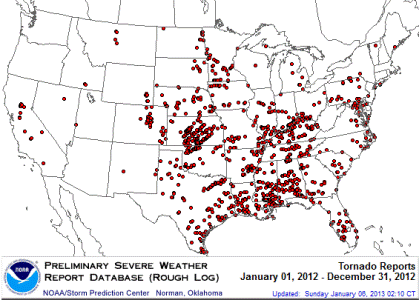
2012 Tornado Occurrences
Source: SPC
On the heels of one of the most destructive tornado years on record for the country (2011), tornado activity during 2012 was below average. During 2012, there were 878 confirmed tornadoes during January–October, with 58 tornado reports still pending for November and December according to data form the Storm Prediction Center. The 1991-2010 annual tornado average is 1,253 and 2012 marks the slowest tornado year since 2002 when there were 934 tornadoes. If the confirmed tornado count is below 935, depending on the confirmation rate of the end-of-year tornadoes, 2012 could be the slowest tornado year since 1989 which had 856 tornadoes. Despite the slower-than-average year for tornadoes, there were still several large, destructive, and deadly tornado outbreaks during the year. Three tornado outbreaks caused at least one billion dollars in damage and there were 68 tornado-related fatalities.
The last tornado-related fatality in the U.S. occurred on June 24th, so December 31st was the 190th consecutive day without a tornado-related fatality. According to analysis by the Storm Prediction Center, the longest consecutive day stretch with no tornado fatalities in the 1950-present official record was 197 days between August 15th 1986 and February 28th 1987. Longer periods without tornado fatalities have occurred prior to 1950, but inconsistent observing practices make comparisons to current data difficult.
The 2012 tornado year started off above average, with above-average tornado activity for each month between January and April. The lack of storm systems during the late spring and summer across the Great Plains was associated with a lack of tornadoes. May and June, which are typically the most active months of the year, both had less than 50 percent of average number of tornadoes confirmed. The below-average tornado activity continued through November. The most active regions of the country during 2012 were the Central Plains, the Gulf Coast, and the Ohio Valley. An active storm pattern during December along the Gulf Coast caused the monthly tornado count to be above average, according to preliminary data. The tornadoes that did form during 2012 tended to be weak to moderate strength in nature. There were only four EF-4 tornadoes, the least since 2009, with no confirmed EF-5 tornadoes during the year.
NOAA's National Climatic Data Center is the world's largest active archive of weather data. The preliminary temperature and precipitation rankings are available from the center by calling: 828-271-4800.
NOAA works closely with the academic and science communities on climate-related research projects to increase the understanding of El Niño and improve forecasting techniques. NOAA's Climate Prediction Center monitors, analyzes and predicts climate events ranging from weeks to seasons for the nation. NOAA also operates the network of data buoys and satellites that provide vital information about the ocean waters, and initiates research projects to improve future climate forecasts.
 NOAA's National Centers for Environmental Information
NOAA's National Centers for Environmental Information
